Serviços Personalizados
Journal
Artigo
Indicadores
-
 Citado por SciELO
Citado por SciELO -
 Acessos
Acessos
Links relacionados
-
 Similares em
SciELO
Similares em
SciELO
Compartilhar
Psicologia
versão impressa ISSN 0874-2049
Psicologia vol.11 no.1 Lisboa jan. 1996
https://doi.org/10.17575/rpsicol.v11i1.590
Spontaneous Activation of Schemata under Stress Getting control over earthquake threat1
Maria Luísa Lima*
*ISCTE, Lisboa
Problem and Theoretical Approach.
The idea that a sense of control or mastery is an essential part of psychological wellbeing has been widely accepted. But research has repeatedly found that perceptions of control go far beyond our actual capabilities to master the environment, and they are extended to situations were no objective control is exerted (e.g., Langer, 1975). Contrarily to objectivistic views of mental health, beliefs of control over uncontrollable events have been found to positively relate to wellbeing (Taylor, 1983; Taylor & Brown, 1988). Within this kind of approach, coping with earthquake threat is an interesting topic to study because it deals with coping with a highly destructive and uncontrollable event. As a matter of fact:
1. Earthquake hazard is the most threatening natural hazard that Portuguese population has to face.
2. Although seismic phenomena are well characterised by the geophysical Sciences, it is still impossible to accurately predict the occurrence of such a destructive event.
3. According to our previous research, people perceive seismic risk both as a highly uncontrollable risk and a risk that affects themselves. Nevertheless, other studies on the Portuguese population show that the common citizen is not informed about what to do in case of an earthquake.
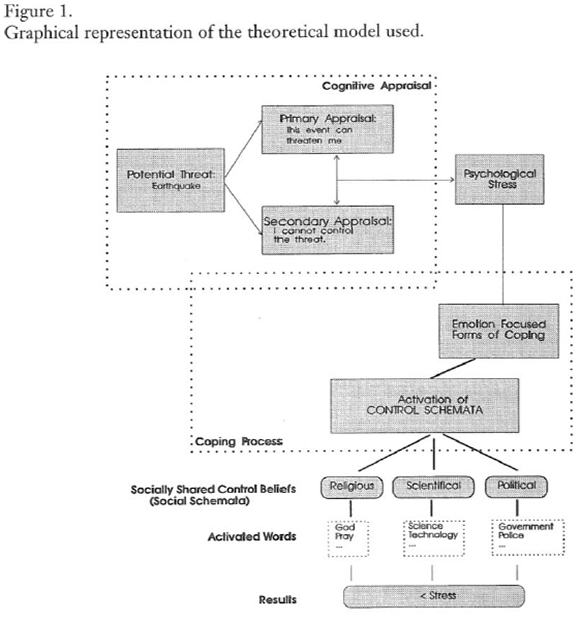
In Lazarus and Folkman’s (1984) model of stress, tdie possibility of an earthquake, being perceived as personally threatening (primary appraisal) and uncontrollable (secondary appraisal), corresponds to a «stressor», leading to psychological and physiological stress responses. As there is nothing to do to prevent the earthquake to happen, according to the same model people will engage in emotion focused coping strategies to deal with the unpleasant feelings the threat imposes on them.
Research on systematic exposition to hazards has shown that people who live in hazard prone environments develop some cognitive adjustments to deal with danger and uncertainty (e.g., Kates, Burton and White, 1978). In line with those results, we have shown in a field study (Lima, 1991) that people who move to an environment with higher levels of seismic risk present stronger control beliefs over the earthquakes than those who remained in lower seismic risk areas. Those control beliefs are a kind of vicarious secondary control (Rothbaum et. al., 1982), whereby people rely on some more powerful agent to restore their sense of control over the environment. In our research, although subjects perceived earthquakes as externally determined, they could still keep some control over the phenomenon, rising three types of socially produced control beliefs:
Religious Control. If God is considered as the ultimate determiner of earthquakes, believers can start a serie of actions in order to influence God’s Will (to pray, to make a promise) and to prevent a disaster.
Scientific-Technical Control. If earthquakes are considered as natural phenomena and Science is seen as efficient to deal with nature, we can suppose that the confidence on Science and technology is another form of restoring the control over an uncertain situation.
Political Control. If there is political trust, if people believe that their government has efficient plans to deal with a disaster, they can restore their sense of mastering over the environment.
In line with those results, this póster presents an experimental study that tries to show that: When earthquake threat is made salient, people will spontaneously activate control schemata to cope with the threat. This hypothesis will be tested in three studies, each one dealing with a specific kind of control beliefs: Religious, Scientific and Political.
Method
Subjects.
480 students participated in these studies, which ran on two phases. On the First Phase, all subjects answered a questionnaire containing a control over the earthquake beliefs scale (Lima, 1991, see Table 1, p. 60) and a trait anxiety scale (STAI-Y2, Spielberger et al., 1983). The second part of the experiment took place a mounth later. On this Second Phase 79 subjects (St1:N=24; St2:N=28; St3:N=27) were selected, according to (i) their anxiety levels: low trait anxiety subjects; and (ii) strength of control beliefs: either very high (schematic subjects) or very low aschematic subjects) on each of the three types of control beliefs).
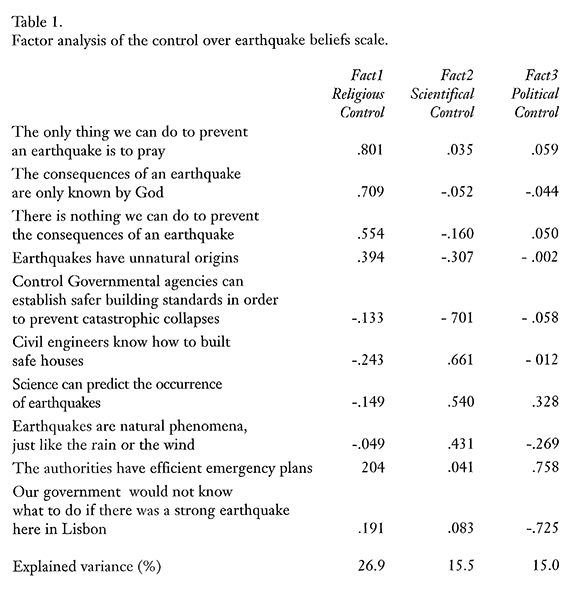
Manipulated variable.
The independent manipulated variable in this study was «earthquake threat». In each of the three studies, subjects were randomly assigned to either the experimental or the control conditions.
In the experimental condition (Threat) subjects were told that they would participate in a study concerning the responses to an emergency situation. They were trained in the experimental task until they fully understood it, and they were asked to watch a 3 minutes video/film about earthquakes. Immediately afterwards, the experimental task took place.
In the control conditions, subjects rehearsed the experimental task and afterwards they performed it.
Experimental task.
The task employed was a word location test (Cambor et al., 1988; Stward et al1991). Subjects were asked to press a key (left or right) as quickly as possible in response to the location of a target word. The target word was presented either above or bellow a fixation point, indicated by in the Center of a Computer monitor. Target words were presented for 5 00 mseconds, with a 1.5 seconds interval between trials. Reaction times (RTs) were recorded. Each subject practised on a series of 10 neutral words. The experimental task consisted of 52 words, including 26 schema related words (i.e., «God» for religion schematic subjects; «engeneering» for the Science schematic subjects and «government» for the politic schematic subjects) and 26 neutral words paired on length and frequency with the others.
Results.
Study 1. Religious schema.
A three way ANOVA (with repeated measures on the last factor) was performed on the mean RTs : Experimental condition (control vs. threat) x Group ( schematic vs. aschematic) x Valence (schema related word vs. neutral word). Results show that all subjects respond quicker to neutral than religious words, except schematic subjects under threat. In that situation, religious subjects respond quicker to the schema related words than to the neutral words (Table 2 and Figure 2). This result, compatible with our predictions, allows us to say that in a condition of earthquake threat, religious subjects spontaneously activate their control beliefs in order to restore their sense of control over the environment. Separate ANOVAS performed on neutral and schema related words confirm this result: while there is no signifficant effect for the neutral words (Exp.Cond. F(1,20)=.088, p>.70; Group F(1,20)=.883, p>.30; Interaction F(1,20)=.378, p>.70), there is a signifficant interaction in the case of religious words (Interaction F(1,20)=5.44, p<.03; Exp. Cond. F(1,20)=.422, p>.50; Group F(1,20)=.895, p>.30).
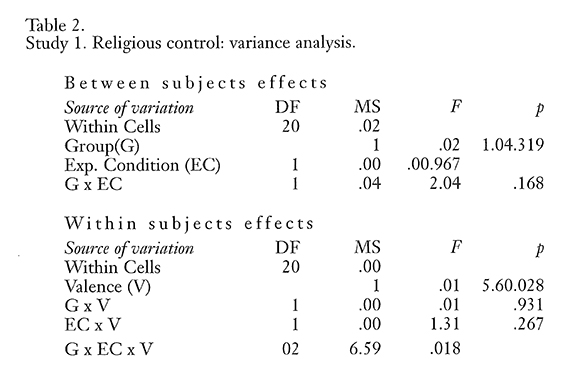
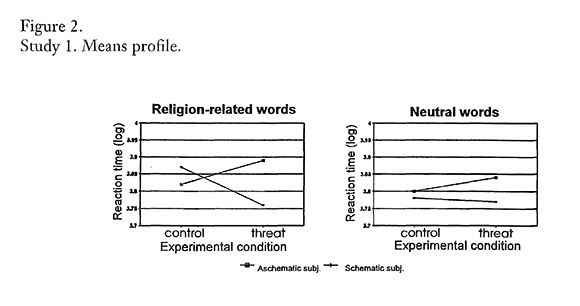
Study 2. Scientific-Technical schema.
A three way ANOVA (with a repeated measure on the last factor) was performed on the mean RTs : Experimental condition (control vs. threat) x Group (schematic vs. aschematic) x Valence (schema related word vs. neutral word). Contrarily to our predictions, no significant effects were found. Separate ANOVAs performed on neutral and schema related words do not show any signifficant effects either (Table 3 and Figure 3).
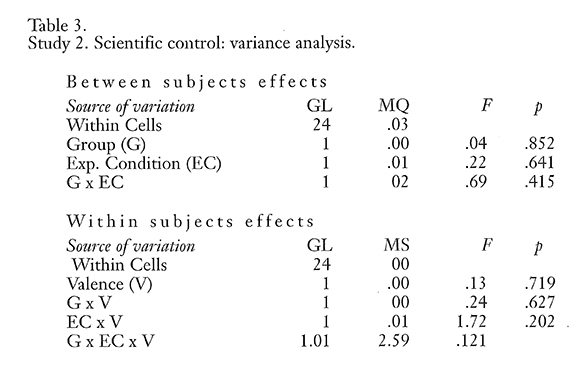
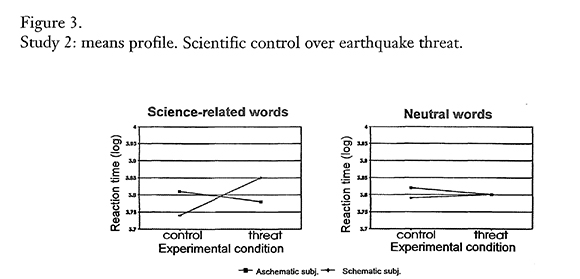
Study 3. Political schema.
The same kind of ANOVA was performed on RTs related to this kind of schema. The pattern of results is very similar to the first study, though the results only approach the significance level. Separate 2 (Group) x 2 (Experimental Condition) ANOVAS were performed for each type of word (Table 4 and Figure 4).
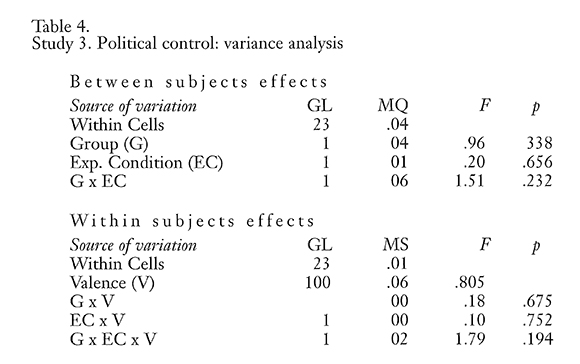
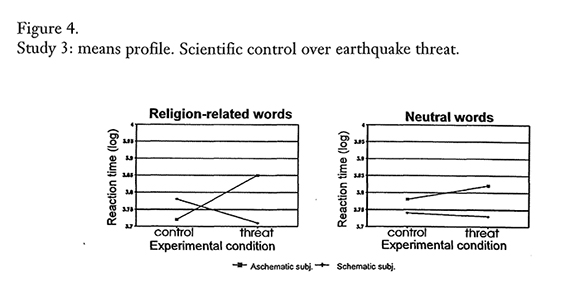
For schema related words, only the interaction effect approaches the significance levels (Interaction F(1,23)=2.97, p<.09; Exp. Cond. F(1,23)=.237, p>.60; Group F(1,23)=.387, p>.50). For neutral words there are no significant effects (Exp.cond. F(1,23)=.055, p>.80; Group F(1,23)=1.065, p>.30; Interaction F(1,23)=.233, p>.60).
These results tend to show that only schematic subjects under stress preferentially process schema related words, in order to regain the sense of control over the threat.
Conclusions.
Our results show that two kinds of control schemata are activated by subjects in an earthquake threat condition: religious and political control schemata. We could find no evidence for the activation of the scientific schema in the same situation.
These kind of control schemata, as we argued elsewhere (Lima, 1990), are cognitive products of interactive social groups, who, for a long time, have managed to cope with stress in a earthquake prone area. The individual activation of these kind of cognitive structure in a threat situation is, on our view, an example of both the impact of social factors on individual cognition and the motivationally driven cognitive processing.
References
Cambor, R., Shear, M. K., Speilman, L Bargh, J. & Sweeney, J. (1988) Attentional bias in panic disorder. [ Links ] Communication presented at the 141 th Annual Meeting of the American Psychiatric Association, Montreal, May
Kates, R. W., Burton, I. & White, G.F. (1978) The environment as hazard. New York: Oxford University Press. [ Links ]
Langer, E. J. (1975) The illusion of control. Journal of Personality and SocialPsychology., 32, 311-328. [ Links ]
Lazarus, R. S. & Folkman, S. (1984) Stress, Appraisal and Coping. New York: Springer. [ Links ]
Lima, M. L. (1990) «Controlar o incontrolável: esquemas cognitivos de adaptação ao risco sísmico». Revista de Psicologia Social, 5 (2-3): 171-183. [ Links ]
Lima, M. L. (1991) «Cognitive schemata to cope with seismic risk: moving to a high risk environment» [ Links ]. Póster presented to the International Conference Stress, Anxiety and Emotional Disorders. Braga, July.
Rothbaum, F., Weisz, J. R. and Snyder, S. S. (1982) «Changing the world and changing the self: a two process model of perceived control». Journal of Personality and Social Psychology, 42: 5-37. [ Links ]
Steward, S. H., Achille, M., Dubois-Nguyen,I. & Phill, R.O. (1991) Sellective attention bias for threat in anxiety sensitive subjects. [ Links ] Póster presented to the International Conference Stress, Anxiety and Emotional Disorders. Braga, July.
Taylor, S. E. (1983) Adjustment to threatening events: A theory of cognitive adaptation. American Psychologist, 38: 1161-1173. [ Links ]
Taylor, S.E. & Brown J. (1988) Illusion and well being: A social psychology perspective on mental health. Psychological Bulletin, 103:193-210. [ Links ]
Financed by
Research for this study was supported by a grant from Instituto Nacional de Investigação Científica (Proc. 29 558).
Notas
1The author thanks all the colleages and students from Escola Superior de Enfermagem Calouste Gulbenkian, Escola Superior de Enfermagem Artur Ravara e Escola Superior de Enfermagem Francisco Gentil, who made this study possible.














